- Home
- Blog
- Additives and Labels
- Food claims: fat-free or guilt-free?
Food claims: fat-free or guilt-free?
Written by Catherine Saxelby
on Friday, 28 November 2008.
Tagged: cholesterol, high cholesterol, label, low fat, monosodium glutamate, MSG, preservatives, salt, sugar

What do those brightly-coloured words that scream "fat-free" or "light" at you at the supermarket really mean? And what about "no cholesterol" or "high fibre" on the label? Some manufacturers make claims that are designed to attract your attention and make you choose their product over another. But take care! They don't always mean what you think they do and often emphasise one aspect (like low-fat) over another (like salt or sugar).
Here are the official guidelines which tell you what those nutrition claims really mean.
97% fat-free
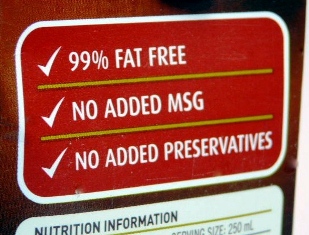 This really means that the food contains 3 per cent fat (or 2 per cent or 1 per cent). But saying it the other way around makes it sound healthier for you! Technically only foods that are 97 per cent, 98 per cent and 99 per cent fat-free can make this claim.
This really means that the food contains 3 per cent fat (or 2 per cent or 1 per cent). But saying it the other way around makes it sound healthier for you! Technically only foods that are 97 per cent, 98 per cent and 99 per cent fat-free can make this claim.
Fat-free
For a food to claim that it's "fat-free", it must have less than 0.15 per cent fat. This is usually a red-herring. It's put on foods that never had any fat anyway, like confectionery, to draw your attention away from the amount of sugar it contains.
Examples: boiled sweets, marshmallows, gelato, sorbet, ice blocks, yoghurts, salad dressings.
Light or Lite
"Light" doesn't necessarily mean that the product is low in fat or kilojoules. Check the characteristic being "lightened", for example:
- light potato crisps are thinly sliced and lightly salted (but may still have the same amount of fat) and just because they're thinly sliced doesn't make any difference if you still eat the whole pack!
- light beer is low in alcohol
- light olive oil has a blander flavour and lighter colour but the same fat and kilojoules as regular olive oil
- light cheese has less fat and salt than the usual cheese but may be still high in fat
- light margarine (spread) has less fat.
"Light" or "lite" products generally contain 25 per cent less fat than the regular product. Some - like yoghurts, dairy desserts, milks and margarine spreads - offer genuine reductions in fat and kilojoules without compromising taste and texture and are valuable foods.
They save you kilojoules and help you shed weight. But not always.
Examples: light milk, light peanut butter, light cheese, light cream, light sour cream, light ice cream, light coconut cream.
Vegetable oil
Don't be fooled into thinking this means an unsaturated vegetable oil such as canola, olive, soya bean, sunola or cottonseed oil. The words "vegetable oil" usually means palm oil, a tropical oil with 50 per cent saturated fat, which is widely used by the food industry to fry fast foods and snack foods.
Like all oils, it has no cholesterol but is high in saturated fat and not recommended as part of a healthy diet. "Vegetable oil" can also mean a hydrogenated (hardened and therefore saturated) vegetable oil. Read the label carefully.
Cholesterol-free or No Cholesterol
These do not mean NO FAT. Many foods such as oils can be free of cholesterol (technically under 3mg per 100g) but remain high in fat. All plant-derived products are free of cholesterol anyway. Stop worrying about dietary cholesterol, it is saturated fat that matters most.
Examples: many oils, margarine, avocado, snack foods, yoghurt, muesli bars.
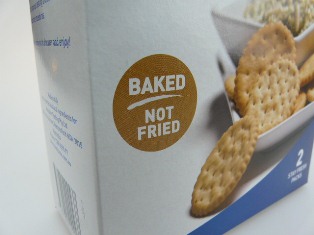
Baked not fried
Examples: snack foods (pretzels) and biscuit snacks (Shapes, rice crackers), rice snacks (Sakata).
No added chemicals
This is a somewhat meaningless term as all food is composed of "chemicals". But it translates to mean something more natural and less processed and would be better served by saying "No artificial colours, flavours or preservatives".
No artificial colours or flavours
This is a key selling point with consumers but is often over-used and put on food labels where colours and flavours are not permitted anyway e.g. breads and breakfast cereals which are not permitted to contain artificial colours and flavours: they can still contain natural colours (like beta-carotene or caramel) or flavours and these will be stated on the ingredient list.
Examples: bread, cereals, muesli bars, custard, canned vegetables, canned tomatoes, pasta, confectionery without artificial colours.
No preservatives
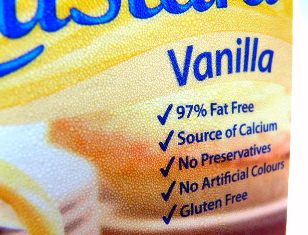 Usually this claim lets you know that no chemical preservatives are present although other methods of preservation - like pasteurisation or vacuum-sealing - may have been used.
Usually this claim lets you know that no chemical preservatives are present although other methods of preservation - like pasteurisation or vacuum-sealing - may have been used.
Because consumers are so fearful of additives, this term often appears on food packs as "reassurance", even if preservatives are not permitted in that class of foods.
No MSG
In theory, this claim is misleading as there are many sources of natural glutamates which may be present in many foods, especially protein foods. "No added MSG" is more realistic, but does not solve the problem of how to avoid glutamate if you need to. Mushrooms, cheese, tomatoes and meat are all rich in natural glutamates, which contribute to flavour.
Examples: soups, gravies, cooking sauces, noodles, Asian flavour bases.
No added sugar/Sugar-free
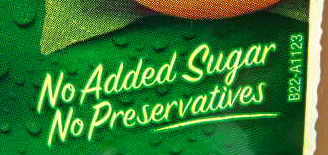 These products must not contain any added sugar but may contain their own natural sugars, say from fruit (fructose) or milk (lactose).
These products must not contain any added sugar but may contain their own natural sugars, say from fruit (fructose) or milk (lactose).
Examples: juices, diet soft drinks, boiled sweets.
Low-salt
Low-salt foods must contain no more than 120mg of sodium per 100g. Generally these are unsalted products like unsalted butter or margarine.
Examples: low-salt canned tomatoes, low-salt baked beans, low-salt margarine
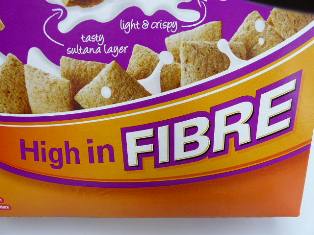
High in fibre
The food must contain 4 grams of fibre or more per serve.
Examples: bran breakfast cereals, oats, multigrain breads, baked beans.
How low is low?
If you're trying to cut back on fat, salt and sugar and eat plenty of fibre, here's an easy guide to what figures you should check out on the nutrition information panel:
| Nutrient |
How much? |
| Fat | 3 grams per 100 grams (3 per cent ) or less |
| Sugars | 20 grams per 100 grams (20 per cent) or less |
| Sodium | 120 milligrams or less per 100 grams |
| Fibre | 4 grams per serve or more |
The bottom line
Don't be taken in by sometimes-meaningless claims - READ THE LABEL for yourself!
Save
Sav
You may also be interested in...
Foodwatch
The Good Stuff
The Boring Stuff
© 2025 Foodwatch Australia. All rights reserved
Website by Joomstore eCommerce








